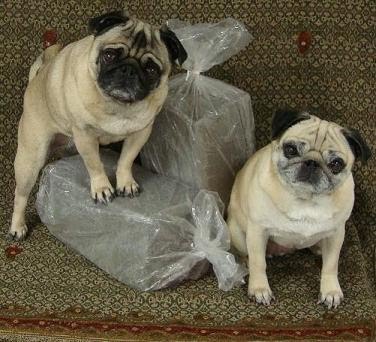When I'm working long hours and my mind wanders to the why of animal art pottery, I invariably glance over at history on the shelf. My animal art pottery collection is not large, but it covers a range of clays and techniques and serves as both reference and inspiration. Here are two ceramic Pugs of very different "pedigrees" that remind me how to capture the character of the breed.

The white glazed Pug in the golden barrel is a salt shaker by Royal Worcester, dating from 1867-1875, as best I can tell from its mark. The decorating technique is detailed down to the red overglaze woodgrain patterns on the barrel's gold-overglazed staves. The mold has excellent detail, even down to the tail poking out the barrel hole. This Pug seems to be trying to free himself after falling into a barrel, and is panting with the effort. His entire head is covered with the shaker holes, negating any room for forehead wrinkles, although ceramic Pugs of this era were often smooth-headed. In the ceramics world, despite his long 19th century nose, this Pug is truly a blueblood.
By contrast, the humble black Pug bitch may date from the 1960's, and is by Alberta Booth. She made many pottery dog breed figurines, and, like me, made her own sculptures, molds, and glazed all of her ware. From a little online reading, I learned that Ms. Booth continued her pottery up until about 2006, at age 89, when her sight began to fail and forced her to stop. I hope that I have the good fortune to have such a long life, and be making my ware at that age, to boot! This little Pug has the characteristic cocked head and forward ears of interest. The forehead is well wrinkled, and the tail double-curled and set on top of the back. Even though standing (stacked) for show, and solid black so details are hard to see, this Pug has expression.
In fact, both of these pieces illustrate how to show breed character, despite a lack of face shading and fawn color. They are lessons in the basics of modelling a breed for ceramic production. When I have a doubt, I ask myself if my Pug sculpture would read as a typical Pug, even if glazed solid white or black. A big thank you to Jo Ellen for gifting me with both of these charming instructors in Pug art.


No comments:
Post a Comment